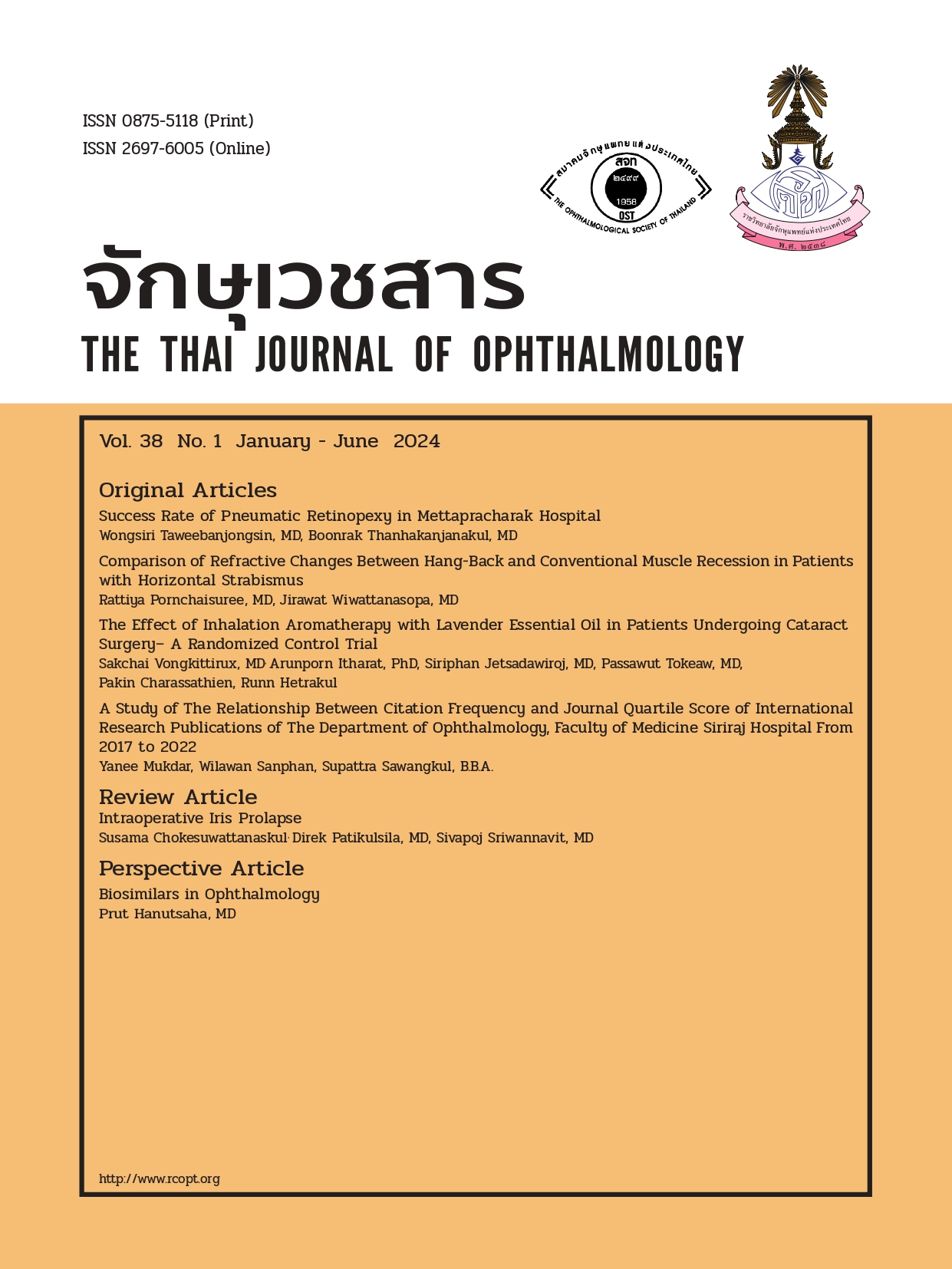Intraoperative Iris Prolapse
ภาวะม่านตายื่นออกมาจากแผลระหว่างการผ่าตัด
Keywords:
cataract surgery, intraoperative iris prolapse, intraoperative floppy iris syndromeAbstract
none
References
References:
Chang DF, Campbell JR. Intraoperative floppy iris syndrome associated with tamsulosin. J Cataract Refract Surg. 2005;31(4):664-673. doi:10.1016/j.jcrs.2005.02.027.
Lim LA, Frost A. Iris tears secondary to intraoperative floppy-iris syndrome associated with tamsulosin. J Cataract Refract Surg. 2006;32(10):1777. doi:10.1016/j.jcrs.2006.05.021.
Haridas A, Syrimi M, Al-Ahmar B, Hingorani M. Intraoperative floppy iris syndrome (IFIS) in patients receiving tamsulosin or doxazosin-a UK-based comparison of incidence and complication rates. Graefes Arch Clin Exp Ophthalmol. 2013;251:1541–1545.
Yurika Terauchi, Hiroshi Horiguchi, Takuya Shiba, "The Pharmacological Mydriatic Pupil-to-Limbal Diameter Ratio as an Intuitive Predictor for the Risk of Intraoperative Floppy Iris Syndrome", Journal of Ophthalmology, vol. 2018, Article ID 2837934, 7 pages, 2018. https://doi.org/10.1155/2018/2837934.
Ernest PH, Kiessling LA, Lavery KT. Relative strength of cataract incisions in cadaver eyes. J Cataract Refract Surg. 1991;17 Suppl:668-671. doi:10.1016/s0886-3350(13)80681-5.
Ernest PH, Lavery KT, Kiessling LA. Relative strength of scleral corneal and clear corneal incisions constructed in cadaver eyes. J Cataract Refract Surg. 1994;20(6):626-629. doi:10.1016/s0886-3350(13)80651-7.
Ernest PH, Fenzl R, Lavery KT, Sensoli A. Relative stability of clear corneal incisions in a cadaver eye model. J Cataract Refract Surg. 1995;21(1):39-42. doi:10.1016/s0886-3350(13)80477-4.
Simaroj P, Lekhanont K, Charukamnoetkanok P. Modified Surgical Techniques for Managing Intraoperative Floppy Iris Syndrome. Case Rep Ophthalmol Med. 2016;2016:1289834. doi:10.1155/2016/1289834.
Ling R, Cole M, James C, Kamalarajah S, Foot B, Shaw S. Suprachoroidal haemorrhage complicating cataract surgery in the UK: epidemiology, clinical features, management, and outcomes. Br J Ophthalmol. 2004;88(4):478-480. doi:10.1136/bjo.2003.026138.
Chatziralli IP, Peponis V, Parikakis E, et al. Risk factors for intraoperative floppy iris syndrome: a prospective study. Eye (Lond). 2016;30(8):1039-1044. doi:10.1038/eye.2016.122.
Wilbrandt HR, Wilbrandt TH. Pathogenesis and management of the lens-iris diaphragm retropulsion syndrome during phacoemulsification. J Cataract Refract Surg. 1994 Jan;20(1):48-53. doi: 10.1016/s0886-3350(13)80043-0.
Lim DH, Shin DH, Han G, Chung ES, Chung TY. The Incidence and Risk Factors of Lens-iris Diaphragm Retropulsion Syndrome during Phacoemulsification. Korean J Ophthalmol. 2017 Aug;31(4):313-319. doi: 10.3341/kjo.2016.0050.
Carifi G, Safa F, Aiello F, Baumann C, Maurino V. Cataract surgery in small adult eyes. Br J Ophthalmol. 2014 Sep;98(9):1261-5. doi: 10.1136/bjophthalmol-2013-304579. Epub 2014 Apr 23.
Bendel RE, Phillips MB. Use of Atropine Prior to Cataract Surgery to Avoid Intraoperative Floppy Iris Syndrome in Patients Taking Flomax ®. Invest. Ophthalmol. Vis. Sci. 2006;47(13):675.
Nuzzi R, Arnoffi P, Tridico F. Best Prophylactic Strategy in Groups at Risk of Intraoperative Floppy Iris Syndrome Development: Comparison Between Atropine Instillation and Adrenaline Intracameral Injection. Open Ophthalmol J. 2018;12:34-40. Published 2018 Mar 30. doi:10.2174/1874364101812010034.
Hashemi H, Seyedian MA, Mohammadpour M. Small pupil and cataract surgery. Curr Opin Ophthalmol. 2015 Jan;26(1):3-9. doi: 10.1097/ICU.0000000000000116.
Nikeghbali A, Falavarjani KG, Kheirkhah A. Pupil dilation with intracameral lidocaine during phacoemulsification: Benefits for the patient and surgeon. Indian J Ophthalmol. 2008;56(1):63-64. doi:10.4103/0301-4738.37598.
Lawuyi LE, Gurbaxani A. The clinical utility of new combination phenylephrine/ketorolac injection in cataract surgery. Clin Ophthalmol. 2015 Jul 10;9:1249-54. doi: 10.2147/OPTH.S72321. PMID: 26203214; PMCID: PMC4506037.
Myers WG, Edelhauser HF. Shortage of bisulfite-free preservative-free epinephrine for intracameral use. J Cataract Refract Surg. 2011 Mar;37(3):611. doi: 10.1016/j.jcrs.2010.12.034.
Silverstein SM, Rana VK, Stephens R, et al. Effect of phenylephrine 1.0%-ketorolac 0.3% injection on tamsulosin-associated intraoperative floppy-iris syndrome [published correction appears in J Cataract Refract Surg. 2018 Dec;44(12):1537] [published correction appears in J Cataract Refract Surg. 2019 Jan;45(1):117]. J Cataract Refract Surg. 2018;44(9):1103-1108. doi:10.1016/j.jcrs.2018.05.029.
Sallam A., El-Defrawy H., Ross A. Bashir, S., Towler Hamish MA. Review and update of intraoperative floppy iris syndrome. Expert Rev. Ophthalmol. 6(4), 469–476 (2011).
Chan, D.G., & Francis, I. (2005). Intraoperative management of iris prolapse using iris hooks. Journal of cataract and refractive surgery, 31 9, 1694-6 .
Oetting TA, Omphroy LC. Modified technique using flexible iris retractors in clear corneal cataract surgery. J Cataract Refract Surg. 2002;28(4):596-598. doi:10.1016/s0886-3350(01)01100-2.
Tint NL, Yeung AM, Alexander P. Management of intraoperative floppy-iris syndrome-associated iris prolapse using a single iris retractor. J Cataract Refract Surg. 2009;35(11):1849-1852. doi:10.1016/j.jcrs.2009.06.020.
Published
Issue
Section
License
Copyright (c) 2024 The THAI Journal of OPHTHALMOLOGY

This work is licensed under a Creative Commons Attribution-NonCommercial-NoDerivatives 4.0 International License.
The Thai Journal of Ophthalmology (TJO) is a peer-reviewed, scientific journal published biannually for the Royal College of Ophthalmologists of Thailand. The objectives of the journal is to provide up to date scientific knowledge in the field of ophthalmology, provide ophthalmologists with continuing education, promote cooperation, and sharing of opinion among readers.
The copyright of the published article belongs to the Thai Journal of Ophthalmology. However the content, ideas and the opinions in the article are from the author(s). The editorial board does not have to agree with the authors’ ideas and opinions.
The authors or readers may contact the editorial board via email at admin@rcopt.org.


